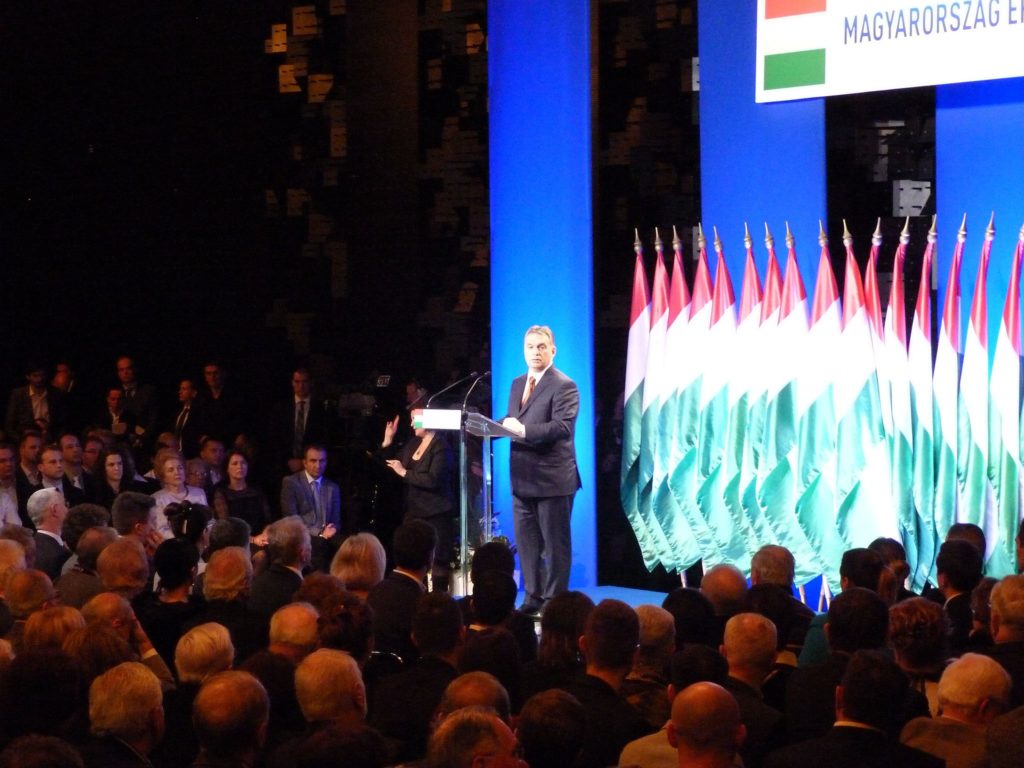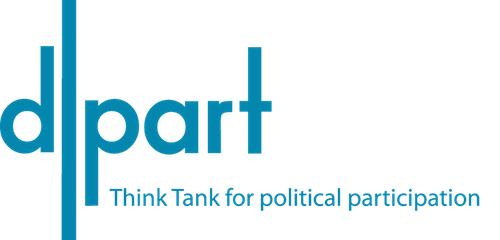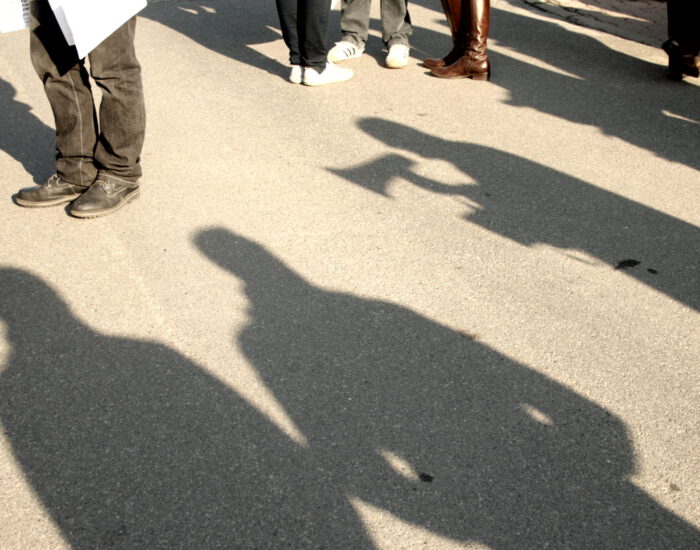The success of the illiberal vision – Orbán’s rise to power
By Krisztian Simon.

Most populist parties start out as radicals, and — once they have managed to build up a solid voter base — they will gradually shift to somewhat more moderate positions, in order to appeal to wider audiences. This, however, does not apply to Hungary’s populist governing party: Fidesz, the Alliance of Young Democrats, was set up as a democratic alternative to the communist youth movement KISZ, and ran as a liberal party on the first free Hungarian elections in 1990. At the time their main target audience was educated young people who were looking for a democratic alternative to state socialism. After a few years the party leadership had to realize that there are limits to growth as a moderate party – so today they promote “illiberalism,” and their popularity is based on fearmongering.
The Fidesz evolution
Fidesz was founded in 1988 by 37 university and college students, mainly from the Eötvös Loránd University’s legal faculty in Budapest – among them party-leader and current Prime Minister Viktor Orbán, János Áder, the current President of Hungary, and László Kövér, the president of the parliament. In 1989 Viktor Orbán rose to international prominence after a speech he gave at the reinterment of Imre Nagy, Hungary’s former prime minister who led the 1956 revolt against the Soviets. In his speech Orbán spoke out for a peaceful revolution and demanded the immediate removal of Soviet troops from the country. In the same year, some members of the party participated in pro-democracy protests in Prague, where Tamás Deutsch – a current Fidesz MEP – was arrested. These events helped Fidesz brand itself as a party of freedom fighters, and become an important political player in the country’s transition to democracy, including its participation in the so called National Roundtable Talks, a set of legalistic discussions between the old government and democratic political organizations about the shape of Hungary’s new democracy.
In 1990 Fidesz had 22 members in the Hungarian parliament, and maintained very close ties with the liberal SZDSZ party (Alliance of Free Democrats). However, some of the liberal members left Fidesz already in 1993 (to join SZDSZ). After SZDSZ got into a coalition with the successor of the communist party (MSZP – Hungarian Socialist Party) in 1994, Orbán and his party – who barely made the 5 percent threshold to secure a place in legislature – used this opportunity to team up with the conservatives (MDF – Hungarian Democratic Forum, who governed Hungary between 1990 and 1994), and reposition themselves as the party of the propertied bourgeoisie: a national conservative party with interventionist economic policies and a very conservative stance on social issues. This turned out to be a successful tactic, as in 1998 Fidesz won the national election, and Orbán was given a chance to form a government — at the age of 35!
In Orbán’s first term (1998–2002) his way of governing did not produce the same waves of international criticism as the second Orbán government did after 2010. Even though there were claims about the party being corrupt and “illiberal” already, at the time there still were a liberal wing in the party and a strong opposition in parliament to act as checks on the government.[1]
Same, same but different
Over the years Orbán has paid much attention to giving his voters the impression that the core message of the party has not changed. He still poses as a freedom fighter who wants to protect his people, but with the years he has adapted his original topics to the changing political environment. The nationalism experts Cas Mudde and Erin K Jenne argue that Poland’s Law and Justice Party and Fidesz are in this sense very similar, as both claim that their often criticized policies represent the realization of the unfulfilled promises of 1989, which were sabotaged by “the communists and dissidents who signed the pacted transitions.”
When Fidesz unexpectedly lost the election in 2002, the party’s slogan became “the homeland cannot be in opposition.” From now on Orbán and his party started to build their messages on demonizing the governing parties and the Hungarian left as enemies of the people. Once they made it back into power in 2010, they defined an additional set of enemies: international financial institutions (especially the IMF), the EU and the Western political elites who – according to Orbán – threaten the country’s national sovereignty. And soon after came NGOs who Fidesz sees as foreign agents paid from abroad to disrupt Orbán’s government. And finally, since 2015, asylum seekers who, according to the government’s propaganda machine, are “economic migrants” who threaten Europe’s culture and even survival.
Illiberalism on the rise
According to the Hungarian political scientist József Bayer, Orbán has adopted practices from other populist parties as an opposition politician, including the person-centered strategic use of the media (and the creation of an own media empire)[2], as well as the establishment of national consultation bodies. When in power, he also started to use the rhetoric of Eurosceptic movements, declaring, for example, that the mainstream political parties do not represent the real interests of the people. “In most European countries — I could honestly say 90 percent of European countries — there is a gap between the opinion of the people and the policy pursued by the elite,” Orbán said to Politico last year. But when it comes to governing, his declared influences can be found east of the EU. He has named a few of them in his widely criticized speech in 2014: China, Singapore, Russia and Turkey are the role models for the illiberal democracy he wants to build in Hungary, because in his opinion “[l]iberal democracy can’t remain globally competitive.”
In this illiberal system, Orbán’s government is defined as the representative of the nation, while Liberalism and liberal democracy are treated as the sources of everything that went wrong in society and the economy. Its ideology is a national collectivistic ideology that favors the national community over the individual, and favors interventions in the cultural, social and economic sphere.[3] In terms of policies, this illiberalism has meant — among others — that Orbán and his government are imposing a strong grip on the media and are exerting influence over the court system. His government also started building a fence at the southern border of the country to keep refugees out at a time when Germany’s Angela Merkel was still advocating open borders for the people who fled the war in Syria. In the context of the EU, Fidesz’s membership in the European People’s Party and its increased cooperation with the other three Visegrád countries (Poland, Czech Republic and Slovakia) on the refugee issue are currently protecting the Orbán government from serious criticism and repercussions inside the EU.
Is being a populist worth it?
As it stands now, Fidesz will most likely stay in power even after the next general election in 2018. There are many reasons for this forecast: first of all, when coming into power in 2010 the party set up a new electoral regime that disproportionally rewards the strongest party. Secondly, the party managed to successfully position itself in the center of the political spectrum between the leftist opposition and Jobbik, a medium-sized far-right party, such that no viable coalition can threaten its dominant position. Moreover, according to analysts, Orbán has an ability “to keep the opposition divided and demobilised, and his fan base united and active” even at times when his support seems to dwindle. Furthermore, the party’s spin doctors have shown plenty of experience in successfully convincing voters to choose Fidesz: before the 2014 elections it was a set of utility price cuts that brought the necessary support for Fidesz, while this year it was the anti-refugee rhetoric that helped Orbán’s party rebound vis-a-vis its extreme right-wing competitor Jobbik. Not to mention that the narrative about the need to protect the Christian nature of Europe has helped Orbán gain a great number of admirers in Europe, from within the German CSU (Christian Social Union in Bavaria) to members of the Austrian FPÖ (Freedom Party of Austria) and Law and Justice in Poland.
–
Krisztian Simon is a freelance journalist, currently based in Budapest, Hungary. He is about to start his PhD in 2016 at the Freie Universität Berlin.
Disclaimer
The views and opinions expressed in this article are those of the author.
–
[1] Bálint Magyar, the former Minister of Education for Hungary, wrote the following about the first Orbán government (1998–2002): “Public funds were dispensed without parliamentary oversight and spent to build private enterprises; public property was transferred to private ownership; the men in power used blackmail to tap into private wealth, and attended to their clientèle from public coffers. Ten years ago, the institutions of liberal democracy were still in a position to constrain this octopus. The battle had not yet been decided; Hungary was not yet a dictatorship, but merely an Orange Republic.” See Bálint Magyar (2012): “Autocracy in Action — Hungary under Orbán.”
[2] When Fidesz lost the national election in 2002, Orbán realized that it needed a “complex and effective media portfolio.” Therefore businesspeople close to the party established Hír Television, and in September 2005, one of the richest entrepreneurs in Hungary, Gábor Széles started his own cable channel, Echo Television, and acquired the daily print Magyar Hírlap. This Liberal daily was transformed into a populist pro-Fidesz news product in only 6 months. More about Orbán’s media aspirations here: Attila Batorfy (2015) — How did the Orbán-Simicska media empire function?
[3] According to the Hungarian journalist Attila Batorfy, during the second Orbán government (2010–2014) the party owned five outdoor/billboard companies (Publimont, Mahir Cityposter, EuroAWK, Euro Publicity, A Plakát), a national and a Budapest-local commercial radio station (Class FM, Music FM), three daily papers (Metropol, Magyar Nemzet, Magyar Hírlap), two weekly papers (Heti Válasz, Demokrata), two television stations (Hír TV, Echo TV), plus the entire public media (M1, M2, Magyar Rádió, MTI News Service, Duna TV) as well as some allies (TV2, Helyi Téma, MNO, Pesti Srácok, etc.). Moreover, the two-thirds majority of Fidesz has helped make functioning impossible for some market competitors through an advertisement tax and its amendments. The Media Authority helped to clean the radio market up for a new radio station, called Class FM, and Fidesz party-members started to “systematically attack” private media companies (like Sanoma, Axel Springer’s Világgazdaság, Origo, Index, RTL Klub). More about this here: Attila Batorfy (2015) — How did the Orbán-Simicska media empire function?
–
Title picture: Orbán giving a speech in Budapest, 27 February 2015, courtesy of Derzsi Elekes Andor (own work), released under Creative Commons.



